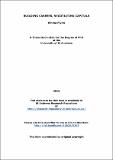Building careers, managing capitals
Abstract
I sought to find out whether this was a tension between artistic and commercial in the
career of visual artists, and if so, how this tension was managed. In attempting to uncover
information which could address the research question I undertook in-depth career
history interviews with artists which covered their time at art school through to their
current practice. The career history method was deliberately chosen in order to address
the research question at a tangent as both the literature, and my own personal experience
of the field of contemporary visual art, had suggested that the topic of artistic and
commercial was a sensitive one. By framing the interviews around the experiences the
artists had through the time period of their training and career, I was able to approach the
research questions indirectly from the perspective of the artists. Through analysis of the
interview transcripts the framework of Bourdieu’s capitals arose as one that would
capably explain the activities which the artists were undertaken and I used this as a
framing device for the empirical chapters in the thesis. In exploring ideas of cultural, social
and economic capitals in relation to how artists describe the activities they undertake
during their career it became apparent that the broad structures of cultural capital needed
further refinement in their application to the careers of visual artists. In the thesis I chose
to elaborate further on the concept of artistic capital which has, until now, been
unexplored by scholars. I have developed an understanding of artistic capital as a
subcategory of cultural capital with particular application to the field of contemporary
visual art – with the potential for wider application beyond the thesis. The three capitals of
artistic, social and economic proved a capable structure for understanding whether there
was a tension between artistic and commercial and how artists managed this. Through
this research I have found that artists come to believe, during their early career and
training through art school, that there is a tension between artistic and commercial as this
is perpetuated by institutions and art world participants through their exclusion or
dismissal of commercial aspects of the visual art field. Through their careers they come to
realise that this tension is less prevalent than they thought and that they are able to
manage these two aspects of artistic and commercial more effectively. However, artists
continue to be faced with instances where this tension is imposed upon them by other art
world players who perpetuate the belief that there is an inherent, unresolvable tension
between artistic and commercial. These individuals attempt to shield artists from this
perceived tension later in their careers when artists are already adept at managing the
competing priorities of artistic and commercial without the two creating tension.
Type
Thesis, PhD Doctor of Philosophy
Collections
Items in the St Andrews Research Repository are protected by copyright, with all rights reserved, unless otherwise indicated.
Related items
Showing items related by title, author, creator and subject.
-
Graphic revolt! Scandinavian artists' workshops, 1968-1975 : Røde Mor, Folkets Ateljé and GRAS
Glomm, Anna Sandaker (University of St Andrews, 2012-01) - ThesisThis thesis examines the relationship between the three artists’ workshops Røde Mor (Red Mother), Folkets Ateljé (The People’s Studio) and GRAS, who worked between 1968 and 1975 in Denmark, Sweden and Norway. Røde Mor was ... -
Artists, patrons and the power of association : the emergence of a bourgeois artistic field in Edinburgh, c.1775-c.1840
Forbes, Duncan (University of St Andrews, 1997-06) - ThesisThe period 1775 - 1840 witnessed a dramatic transformation in the size and complexity of the Edinburgh art world, with the rituals associated with fine art consumption emerging from the closed circles of the elite ... -
The artist as outsider : a comparative study of James Joyce, André Gide and Thomas Mann : with particular reference to 'A portrait of the artist as a young man', 'Les Faux-monnayers' and 'Dr Faustus'
Helm, Arthur Friedrich (1986) - Thesis""The Artist as Outsider" certainly is a very popular subject for literary criticism. Nevertheless, I have chosen it believing strongly that there are two points which I can make and which have not been made before: The ...

